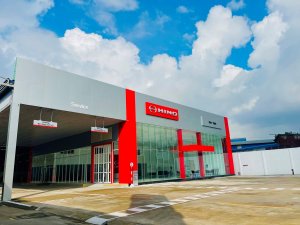Mr. Akio Tanaka is one of the master craftsmen behind the vehicles produced by Hino Motors. With 42 years dedicated to his craft, he produces parts for vehicle prototypes by hand, matching blueprints with perfect precision. His superb skills prompted the Minister of Health, Labor and Welfare to present him with the Award for Outstandingly Skilled Workers* recognizing him as a contemporary master craftsman. Mr. Tanaka is a true Hino Meister, and a modest one at that. “This award is truly an honor, but there are many people working at Hino Motors with the skills to receive this same award,” he says with a hint of pride.

An interest in vehicle prototype creation and further honing his skills first piqued Mr. Tanaka’s interest in working at Hino Motors. From about the time he was in high school, he knew he wanted to work on the production floor crafting things. He was particularly drawn to the field of vehicle prototypes, which relies heavily on skilled craftsmanship. For more than four decades, he has worked leading Hino’s team in vehicle prototype production.
Asked the most important skill in making things, Mr. Tanaka says it is the ability to read drawings and to visualize to be able to make two-dimensional plans into a finished product. Sometimes the design team asks him for input and suggestions on their design drawings to realize even better end products—something that is only possible with years of experience and success. He says that he feels an unmatched sense of accomplishment knowing that his work was spot on when a part he crafts receives high praise from the testing department, the next stage in the production process.
Asked to describe Hino Motors as a company, Mr. Tanaka says it is a strong company that boasts extremely high technological and organizational competencies. He adds, “On an individual level employee are exceptionally skilled and demonstrate outstanding teamwork in manufacturing across the board, making reliable and quality products on time.”
Mr. Tanaka is passionate about training the generation that will follow. They say it takes 10 years to become a full-fledged craftsman, but his current hope is to train upcoming metal workers to be able to fill his shoes as quickly as possible. “I want the younger employees here to enjoy their work,” he says, adding, “Young people today tend to take their work seriously, and I think that makes them a great fi t for the field of manufacturing.” Even with technology advancing at a rapid clip, Mr. Tanaka believes the need for skilled manual craftsmanship will persist when it comes to prototypes.
“Times may be changing, but no matter how much things change, even in an increasingly digital world, I believe that manual craftsmanship will continue to be important and needed for things like creating prototypes,” he says.
Asked about his happiest experiences, Mr. Tanaka recounts, “When I went on vacation to Guam, we happened by this shopping mall. There on display was one of the vehicles I had worked on. That’s when it really hit me that my skills were being used out in the world. This was something that really left an impression on me.” Mr. Tanaka concluded the interview with a message for Hino dealers and customers around the world: “At Hino, we relentlessly repeat testing to refi ne and raise product quality. We’re sure that our trucks and buses will exceed your expectations. More than anything, I hope that people around the world will have the chance to experience the quality that Hino delivers.”
(*) The Award for Outstandingly Skilled Workers was established in 1967 for workers with exceptional skills and who are leading experts in their fields. The objective of the award is twofold: to serve as a goal for craftsmen as well as young people aspiring to work as craftsman and to raise the profile of skilled work and skill standards.
Sourse: Hino Cares Vol. 32






